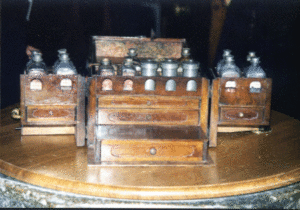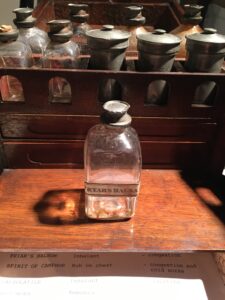Horatio Nelson’s Medicine Chest
In The Private Misadventures of Nell Nobody, Captain Nelson occasionally requests various things from his portable medicine box.
At All Saints Church, in the village of Burnham Thorpe, King’s Lynn, Norfolk, there is a medicine chest which is thought to have been Nelson’s. It looks like this:

Whether it was actually Nelson’s cannot be unequivocally determined because the provenance is not strong. But I had an opportunity to examine it a few years ago and handle the little bottles, noting the labels on each one. I looked up each of those medical preparations and what they commonly used for, and I wrote a two-part article, which appeared in The Nelson Dispatch, the members’ journal of The Nelson Society.
According to their labels, the bottles once contained the following: Goulard’s Extract, Antimonial Wine, Lavender, Tincture of Peruvian Bark, Friar’s Balsam, Ether, Opodeldoc, Sp. Sal Volatile, Sp. Hartshorn, Camphor, and Sp. Wine. (“Sp.” is an abbreviation of “spirits,” and indicates a distillation of the substance.)
The practice of medicine in the late eighteenth century applied both theory and empirical observation. It was (still) based on the ancient humoral theory of Galen, and thus has been called Galenic medicine, sometimes “heroic medicine.” It proceeded from the premise that the body contained four humours: blood, phlegm, black bile, and yellow bile. According to the theory, when these four humours were balanced a person was healthy. If someone became ill, then the humours must be out of balance. Physicians deducted which humour might need balancing, and then applied various methods to achieve the desired result.
Often these methods were rather rough, which is what put the “heroic” in “heroic medicine.” Bleeding a person who was considered “plethoric” was achieved with a fleam—a handheld blade—and a bleeding bowl; the practitioner opened a vein in the arm using the fleam and collected the blood in a bowl. Preparations of herbs or metals were used to induce vomiting or effect a purge. Other procedures raised blisters on the skin to draw off excess water.
Some of the medicines listed above were used for the purpose of “balancing the humours.” But irrespective of the theory, they were used because it was perceived that they worked. Enough people using them had achieved observable, quantifiable results for them to remain in the pharmacopeia.
In my next newsletter, I’ll tell you at least one thing that each preparation in Nelson’s medicine chest was used for.
Until then, I wish you many pleasant hours to spend with some very good books!